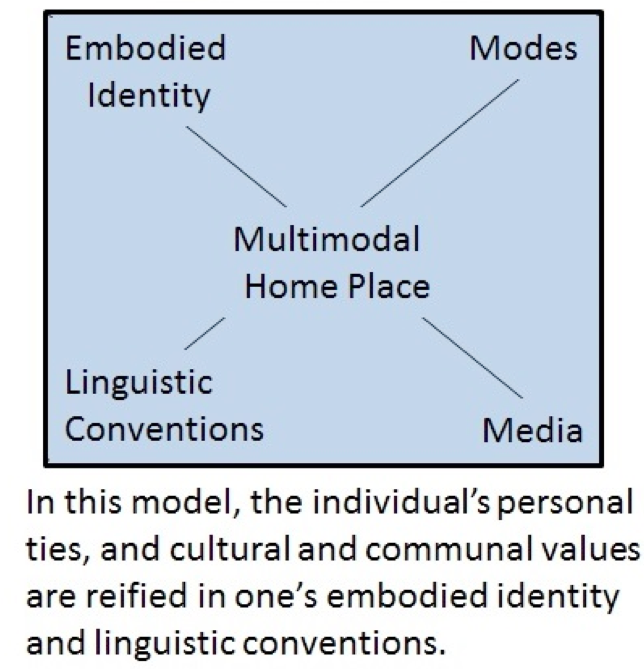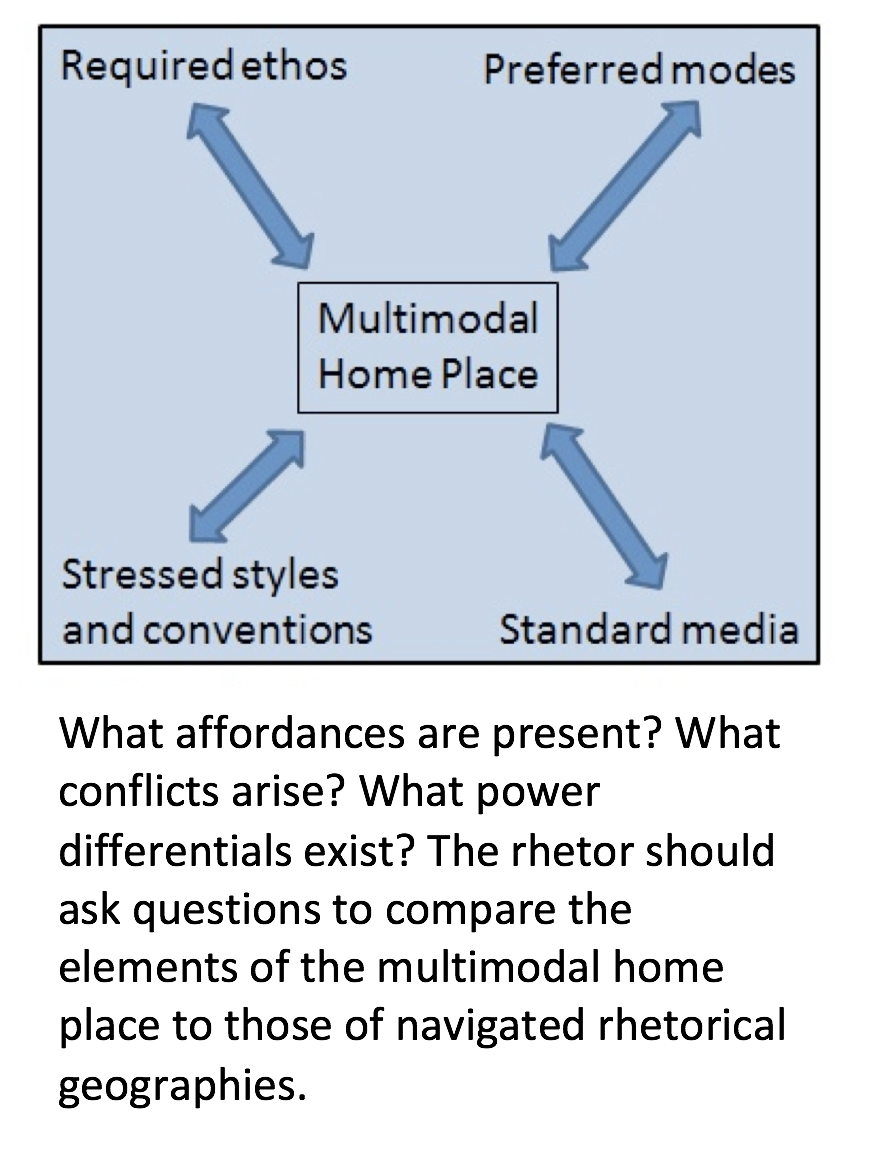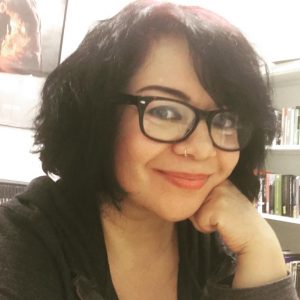Diversity, Technology, and Composition: Honoring Students’ Multimodal Home Places
Technologies aren’t “straightforward, nonproblematic, and transparent” but replicate hegemonic norms and power structures (C. Haas 52). Furthermore, attainment of technological access is usually determined according to dominant culture values, which can further marginalize minoritized groups. As multimodal (especially digital) tools become ever more prevalent features in writing classrooms, students must learn to use them to not only communicate effectively but also understand that technologies bring their own values and cultural capital to bear on writing contexts. Media support particular modalities over others and formally shape and ideologically infuse products based on their affordances. Hence, students must be able to analyze rhetorical contexts while problematizing simplistic definitions of access and efficacy. The concept of a “multimodal home place” provides a tool to help students become more mindful about technology use.
Inspired by Jacqueline Jones Royster’s work on voice and subjectivity, I define the multimodal home place as the ideo-ecological multimodal context of writing, composed principally of students’ community-determined perspectives that inform their rhetorical aims and intent and that complement and/or contest the ethics and attitudes of the dominant culture and those represented by the media and modalities they engage. Below, I explain the multimodal home place to argue that multimodal literacy (indeed, rhetorical training as a whole) must stress technological skills informed by communicative transactions considered meaningful within students’ home communities. Then, I discuss how multimodal home places illuminate issues of access. Finally, I suggest pedagogical strategies that allow instructors to honor students’ home places while promoting skills crucial to multimodal rhetorical literacy.
Multimodal Composition
Communication happens via “messy” material processes of composition that transcend fixed academic spaces (McRuer 53). Still, composition pedagogy tends to focus on final/ized products, leading to the neglect of the “highly distributed, embodied, translingual, and multimodal aspects of all communicative practice” (Shipka 253). Language, culture, media, and context contribute to meaning-making from the standpoint of the composer and those of the audience. Further, working within “complex and multifaceted contexts that are simultaneously material, discursive, social, cultural, and historical” calls for a “kairotic inventiveness” that accounts for a product’s longevity and reach (Sheridan, Ridolfo, and Michel 11, 99). Compositions’ meanings move beyond makers’ intentions and exert rhetorical influence beyond their original exigence. Hence, digital and multimodal composition scholars suggest instructors shift focus from end products to process and assess learning vis-à-vis choices students make in responding to rhetorical stimuli. This shift demands that instructors expand on the process outlined by Donald Murray (prewriting, writing, and rewriting) to underscore “processes of making, engaging, remixing, and transforming” (Shipka 252). It also calls for new means of evaluation (see Ball) that gauge students’ abilities to use “multiple methods of persuasion, effective writing, effective speaking, and media” to devise “inventive ways to bring about outcomes in the world” (Aguayo).
Multimodal composition within complex networks entails deployment of several kinds of expertise. It requires knowing “not all environments for linguistic exchange are created equal in regard to the modal mixing they accommodate” (Selfe qtd. in Shipka 252). It demands awareness of a medium’s “distinct potentials and limitations for representations of the various modes” (Kress 12). And, it involves knowing how modes and media create, extend, and constrain rhetorical space so that “if need be, [they can] use different spaces [that are] . . . rendered unavailable by naturalized, unquestioned practice” (Wysocki 57). A composer must gauge the practical advantages and drawbacks of each mode and medium within specific contexts. To assess these gains and losses, to echo Gunther Kress, composers must judiciously determine affordances provided by media and those provided by modes and approaches to which audiences are accustomed.
Bridging these differences proves crucial to effective communication. Yet, when a rhetor’s habituated choices diverge from those of the intended audience, the former typically appeals to the latter’s expectations. This arrangement works fairly so long as communication takes place in a vacuum—as simple conveyance of information between parties without reference to lived contexts and power differentials. Such scenarios can’t exist because, as Walter Ong argued, “words are never fully determined in their abstract signification but have meaning only with relation to [a person’s] body and to its interaction with its surroundings” (10). When the composer is a member of a marginalized group addressing an audience based in the dominant culture, uncritical concession to audience preferences reproduces hegemonic patterns, reinforcing the centrality of ascendant norms (and their attendant technologies) and contributing to their naturalization by “erasing” their status as but one communication paradigm; therefore, students from minoritized groups must be allowed to honor rhetorical praxes located within their extramural communities while, at the same time, avoiding the ungainly solipsism that can accompany an unexamined view of the self as central to any rhetorical situation. The “multimodal home place” can help students map out habitual modes and media privileged within their imbricated communities, even as they are reminded that everyone they address has their own “home places.”
The Multimodal Home Place
In “When the First Voice You Hear Is Not Your Own,” Royster explains how members of minority groups are made to feel like “subject matter but not subjects” (32). Minoritized groups’ standpoints are assumed to coincide with those of researchers—if not simply overwritten. Royster deploys community-derived standards of courtesy to contest the imposition of outside attitudes and goals.
People in the neighborhood where I grew up would say, “Where is their home training?” Embedded in the question is the idea that when you visit other people’s “home places,” especially when you have not been invited, you simply can not [sic] go tramping around the house like you own the place, no matter how smart you are, or how much imagination you can muster, or how much authority and entitlement outside that home you may be privileged to hold (32).1
Marginalized communities are familiar with paternalistic notions of care, with outsiders passing judgment or making assertions about their needs. Hence, Royster calls for “codes of behavior that can sustain more concretely notions of honor, respect, and good manners across boundaries” (33). Instructors can heed this call by acknowledging the embodied realities of students’ lives too often overlooked in defining literacy.
A “home place” is more than a physical space. It is a complex of personal ties, cultural and communal values, and linguistic conventions that make existence a life—plus the established modalities and technologies needed to express and maintain those relations (See Fig. 1.). People do not leave their home places as they navigate the world. One’s home place influences decision-making as habituated ideals and praxes encounter those fostered by different spaces and as one creates meaning through different modalities and confronts how media reflect the ideologies of users and creators (Lauer 227; Brock 358).

The multimodal home place centers the importance of those norms, values, and attitudes that are homegrown while drawing attention to overlapping geographies that students traverse and the technological conventions associated with each space (See Fig. 2.). It eschews the standard composer-text-audience rhetorical model in favor of a more diffuse, ecological multimodal approach wherein “kairos refers to a struggle between rhetors and their contexts” (Sheridan, Ridolfo, and Michel 21). The concept is nonlinear, multilayered, and diffuse, promoting writing as a “contextualized praxis that is mutually constitutive of writers, readers, texts, and contexts” in “open-ended, indeterminate, messy problem spaces” beyond the classroom (Rosinski and Peeples 11). It stresses rhetorical ethics (since accordance, conflicts, and power differentials between different home places are highlighted) as well as the open-endedness of composition (since members of diverse communities continue to be affected differently by the choices composers make).

Critiquing Technology via the Multimodal Home Place
The multimodal home place can help educators refine simplistic notions of access, which popular discourse frames as a matter of “you either have access to [information and technology] or you do not; you are either connected or not connected” (Selwyn 344). Access depends on more than physical proximity to technology, on “more than the number of DSL lines in a building or computers in a classroom” (Beers 5). As Adam Banks explains, access has functional, experiential, critical, and transformative dimensions: one must be able to use technology skillfully, understand its practical relevance to one’s life, interrogate its possibilities and pitfalls, and find ways to participate in its development (135). Beyond assimilation of particular skill sets and the value systems they represent, access requires that we become critical users who create opportunities for technology to reflect our positionalities. Consideration of students’ multimodal home places demands that instructors recognize students’ diversity of experiences and subjectivity in determining whether access has been achieved in a particular context.
Despite having material access, people cannot benefit from technology if usability is negligible. Usability matters because social contexts defined by normative (and normate) standards do not take students’ unique needs into account. Such standards frame the Subject as a “white, male, straight, upper middle class” person whose body is “profoundly and impossibly unmarked” (Dolmage 110). They measure students’ technological literacy according to the whitestream by default. Criteria that measure proficiency prove arbitrary to students’ lives when these ideals do not harmonize with their real-world constraints. For example, teaching Black students to build webpages that are “inimical to Black identity, culture, and information needs” proves both irrelevant and violent (Brock 358). The calculated usability of resources depends on needs and aims determined by a student’s home place—not only academic criteria.
Additionally, the multimodal home place proves useful in determining critical repurposing of technology, a survival tactic crucial to denigrated groups. Native scholar Malea Powell explains how historical figures have made strategic use of discourses about American Indians—powerful technologies designed to facilitate racism and colonialism—to fashion rhetorics that destabilize the very discourses they engage. Teaching strategic use as a lens through which students may determine their own relationships to technology cannot be underestimated for “[it] is this use that . . . transforms object-status within colonial discourse into a subject-status” (Powell 400). The multimodal home place as an analytical framework highlights different types of technology that affect students in everyday life and registers technology’s manifold effects on individual subjectivity.
Once students ascertain the roles technologies play in their lives, they can develop personalized, empowered approaches to use. Students can respond constructively to preconceived ways that media frame them as users and contest prejudicial discourses that inform those preconceptions or exclude them from technology development and repurposing. The multidirectional quality of today’s digital media means that “the user is no longer limited to the role of receiver” (Carnegie 167) but can interact with developers and audiences; however, students can also analyze how homegrown multimodal practices frame them as receivers against views of themselves as developers and users to imagine new opportunities for invention that enhance traditional and current praxes. They might envision new uses for existing media and prevalent modes to promote social change based on goals determined by their multimodal home places. Deferring to students’ home places proves invaluable when teaching students to use technology critically, to serve the needs of their communities.
The Multimodal Home Place in Practice
A multimodal home place-centered approach to composition, one that deliberately eschews fixed outcomes and methods, encourages educators to avoid imposing well-intentioned but rigid agendas on students’ interactions with technology. Instructors can provide pedagogical direction without compelling specific results.
Students can determine their multimodal home places by cataloging rhetorical interactions they participate in regularly according to location, frequency, discourse community, and technological requirements. They might create brief lists of visual, verbal, and material texts found at school (databases, fliers, books, etc.) and at home (cookbooks, oral histories, films, etc.). Then they can determine how these texts’ attendant modes and media influence their reception, focusing on the ethoi, registers, and resources each communicative context demands. They should then rhetorically analyze the media they encounter at school and at home to compare how media anticipate and exclude certain users, connecting these impressions to subject- or object-status within rhetorical contexts facilitated by these vehicles. For example, students may analyze digital resources available at school facilities to determine the skill sets needed to use them, how and where these skills are acquired, and forms of privilege associated with their use. Students can then analyze home-culture media (such as songs, baskets, quilts, etc.) to discern their required skill sets and modal knowledges. Students can then consider if and how academic resources accommodate these elements.2
Bringing to bear the NCTE Resolution on Students’ Right to their Own Language, instructors can plan assignments that permit multiple outcomes, allowing students to make use of diverse registers and genres to address various audiences and emphasizing meta-critical awareness of rhetorical options over unconscious privileging of hegemonic ideals. They should also provide students opportunities to engage community knowledges. Students can then build resources that speak to real-world needs within their different communities, including elements (like translations, glossaries, or how-to guides) that enhance their usability. Students can employ surveys and interviews with community members to determine what modes and media might make these resources more accessible and invite future community-based development beyond assignment deadlines.3 Ultimately, the instructor’s main goal would be to transform the prescriptive space of the classroom into one that recognizes and reinforces those real-world community literacies that students deploy to engage in “identity construction” and “make sense of both their lives and social worlds” (Mahiri and Sablo 174).
Conclusion
Centering connections between diversity, literacy, and technology rights in rhetorical analysis sheds light on matters of vital importance to underprivileged and minoritized populations. The concept of the multimodal home place privileges homegrown knowledges that instructors might disregard or work to undo as critical benchmarks. It embraces communal and personal literacies that permit students to enter and negotiate different discourse communities organically rather than focusing strictly on finished texts and discrete scenes of composition. Rhetorical spaces and their attendant technologies never exist free of ideology and complex hierarchies. Students’ indiscriminate use of privileged modes and media can contribute to and bolster the impression of a singular, uniform subjectivity defined by dominant culture values. The importance of rhetorical awareness in interrogating and contesting inured standpoints and power relations cannot be underestimated.
To build pedagogies “forged with, not for” students, educators must formulate notions of access and expertise that include students’ personal and communal knowledges (Freire 48). Attention to multimodal home places allows educators “to teach, to engage in research, to write, and to speak with Others with the determination to operate not only with professional and personal integrity but also with the specific knowledge that communities and their ancestors are watching” (Royster 33). Attunement to students’ multimodal home places can clarify whether access and proficiency have been achieved according to each student’s unique world. As a concept, the multimodal home place underscores respect for others’ humanity, selfhood, and space(s); it honors rhetorical instruction—how best to relate to others—gained outside the classroom. It demonstrates respect for students’ home knowledges, allowing these to determine what technologies can best serve students’ needs and those of their communities. Heuristically, it reveals how everyday praxes can resist the presumed authority of homogenous academic epistemologies. Such challenges can facilitate cross-cultural understanding via engagement of perspectival differences and present occasions to “address radical subjectivity frankly,” opportunities all too often lacking in classroom settings (Taylor 171).
Endnotes
- In my own community, “home training” is referred to as “educacíon,” or “education,” the informal instruction one receives regarding good manners rather than formal schooling despite the use of the same word. Likewise, another’s “home place” is called “casa ajena,” which literally means “another’s home” but signifies the need to respect what is not one’s own. Despite these correspondences, I choose to use the expressions used by Royster to deliberately center African American vernacular knowledge, which is typically disregarded in whitestream English language instruction. return
- For more on cultural rhetorics-based analyses of technology, see A. Haas, “Wampum as Hypertext: An American Indian Intellectual Tradition of Multimedia Theory and Practice,” and Keates and Clarkson, “Defining Design Exclusion.” return
- For more on critical community writing, see Getto, Cushman, and Ghosh, “Community Mediation: Writing in Communities and Enabling Connections through New Media,” and Simmons and Grabill, “Toward a Civic Rhetoric for Technologically and Scientifically Complex Places: Invention, Performance, and Participation.” return
Works Cited
- Aguayo, Angela J. “The Bodies That Push the Buttons Matter: Vernacular Digital Rhetoric as a Form of Communicative Agency.” Enculturation, vol. 23, Nov. 2016, enculturation.net/the-bodies-that-push-the-buttons-matter.
- Ball, Cheryl. “Assessing Scholarly Multimedia: A Rhetorical Genre Studies Approach.” Technical Communication Quarterly, vol. 21, no. 1, 2012, pp. 61-77.
- Banks, Adam J. Race, Rhetoric, and Technology: Searching for Higher Ground. Lawrence Erlbaum, 2006.
- Beers, Kylene. “Equality and the Digital Divide.” Voices from the Middle, vol. 11, no. 3, Mar. 2004, pp. 4-5.
- Brock, André. “‘A Belief in Humanity is a Belief in Colored Men’: Using Culture to Span the Digital Divide.” Journal of Computer-Mediated Communication, vol. 11, no. 1, Nov. 2005, pp. 357-74.
- Carnegie, Teena A. M. “Interface as Exordium: The Rhetoric of Interactivity.” Computers and Composition, vol. 26, no. 3, Sept. 2009, pp. 164-73.
- Dolmage, Jay. “Writing against Normal: Navigating a Corporeal Turn.” Composing Media Composing Embodiment, edited by Kristin L. Arola and Anne Wysocki, Utah State, 2012, pp.110-26.
- Freire, Paulo. Pedagogy of the Oppressed. Continuum, 2000.
- Getto, Guiseppe, Ellen Cushman, and Shreelina Ghosh. “Community Mediation: Writing in Communities and Enabling Connections through New Media.” Computers and Composition, vol. 28, no. 2, June 2011, pp. 160-74.
- Haas, Angela M. “Wampum as Hypertext: An American Indian Intellectual Tradition of Multimedia Theory and Practice.” Studies in American Indian Literatures, vol. 19, no. 4, 2007, pp. 77-100.
- Haas, Christina. Writing Technology: Studies on the Materiality of Literacy. Routledge, 1995.
- Keates, Simeon, and P. John Clarkson. “Defining Design Exclusion.” Universal Access and Assistive Technology: Proceedings of the Cambridge Workshop on UA and AT ’02, Springer, 2002, pp. 13-22.
- Kress, Gunther. “Gains and Losses: New Forms of Texts, Knowledge, and Learning.” Computers and Composition, vol. 22, no. 1, 2005, pp. 5–22.
- Lauer, Claire. “Contending with Terms: ‘Multimodal’ and ‘Multimedia’ in the Academic and Public Spheres.” Computers and Composition, vol. 26, Dec. 2009, pp. 225–39.
- Mahiri, Jabari, and Soraya Sablo. “Writing For Their Lives: The Non-School Literacy of California’s Urban African American Youth.” The Journal of Negro Education, vol. 65, no. 2, Spring 1996, pp. 164-18. JSTOR, www.jstor.org/stable/2967311.
- McRuer, Robert. “Composing Bodies; or, De-Composition: Queer Theory, Disability Studies, and Alternative Corporealities.” JAC, vol. 24, no. 1, 2004, pp. 47-78. JSTOR, www.jstor.org/stable/20866612.
- Murray, Donald M. “Teach Writing as Process Not Product.” Cross-Talk in Comp Theory: A Reader. 3rd ed., edited by Victor Villanueva and Kristin L. Arola, NCTE, 2011.
- Ong, Walter J. “The Writer’s Audience Is Always a Fiction.” PMLA, vol. 90, no. 1, Jan. 1975, pp. 9-21. JSTOR, www.jstor.org/stable/461344.
- Powell, Malea. “Rhetorics of Survivance: How American Indians Use Writing.” College Composition and Communication, vol. 53, no. 3, Feb. 2002, pp. 396-434. JSTOR, www.jstor.org/stable/1512132.
- Rosinski, Paula, and Tim Peeples. “Forging Rhetorical Subjects: Problem-Based Learning in the Writing Classroom.” Composition Studies, vol. 40, no. 2, Fall 2012, pp. 9-32.
- Royster, Jacqueline Jones. “When the First Voice You Hear Is Not Your Own.” College Composition and Communication, vol. 47, no. 1, Feb. 1996, pp. 29-40. JSTOR, www.jstor.org/stable/358272.
- Selwyn, Neil. “Reconsidering Political and Popular Understandings of the Digital Divide.” New Media and Society, vol. 6, no. 3, June 2004, pp. 341-62.
- Sheridan, David M., Jim Ridolfo, and Anthony J. Michel. The Available Means of Persuasion: Mapping a Theory and Pedagogy of Multimodal Public Rhetoric. Parlor Press, 2012.
- Shipka, Jody. “Transmodality in/and Processes of Making: Changing Dispositions and Practice.” College English, vol. 78, no. 3, Jan. 2016, pp. 250-57.
- Simmons, W. Michele, and Jeffrey T. Grabill. “Toward a Civic Rhetoric for Technologically and Scientifically Complex Places: Invention, Performance, and Participation.” College Composition and Communication, vol. 58, no. 3, Feb. 2007, pp. 419-48. JSTOR, www.jstor.org/stable/20456953.
- Taylor, Todd. “The Persistence of Difference in Networked Classrooms: Non-Negotiable Difference and the African American Student Body.” Computers and Composition, vol. 14, no. 2, 1997, pp. 169-78.
- Wysocki, Anne Frances. “Awaywithwords: On the Possibilities in Unavailable Designs.” Computers and Composition, vol. 22, no. 1, 2005, pp. 55–62.
Keywords: MULTIMODAL, ACCESSIBILITY, PEDAGOGY, COMPOSITION, TECHNOLOGY
Cover Image Credit: Author




 Christina V. Cedillo is an Assistant Professor of Writing and Rhetoric in the Writing Program at the University of Houston-Clear Lake, where she teaches first-year writing, advanced writing, and writing for education majors. She also teaches a graduate course in cultural histories of rhetoric at the Texas Department of Criminal Justice Ramsey unit through UHCL's Academics for Offenders program. Her research interests include rhetorics of embodiment and embodied rhetorics at the intersections of race, gender and disability, critical pedagogy, and cultural rhetorics.
Christina V. Cedillo is an Assistant Professor of Writing and Rhetoric in the Writing Program at the University of Houston-Clear Lake, where she teaches first-year writing, advanced writing, and writing for education majors. She also teaches a graduate course in cultural histories of rhetoric at the Texas Department of Criminal Justice Ramsey unit through UHCL's Academics for Offenders program. Her research interests include rhetorics of embodiment and embodied rhetorics at the intersections of race, gender and disability, critical pedagogy, and cultural rhetorics.
I’ve been reflecting on multimodality in my FYC assignments, and, in previewing this article, thought of the old saying that when the student is ready, the teacher appears. I’m looking forward to reading this (wishing I had time to drop everything and read).